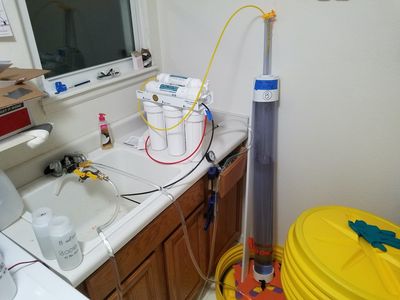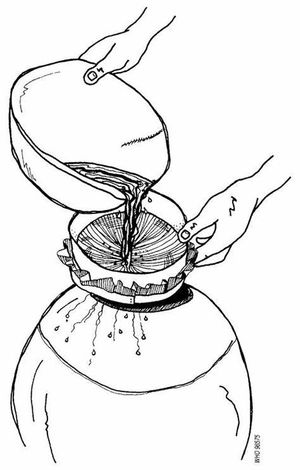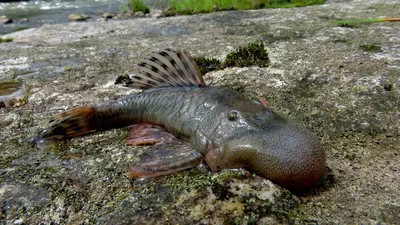Lithium is an element, atomic number 3. It is a soft, light, highly reactive metal with a variety of uses. Among other things, it’s often found as a trace mineral in drinking water. Small amounts of lithium are naturally present in many water sources, but levels of lithium in American drinking water have been increasing for the past 60 years.
In 1964, the US Department of the Interior published a report called Public water supplies of the 100 largest cities in the United States, which found a median lithium concentration of only 2.0 µg/L in US drinking water. The highest level they recorded was 170 µg/L.
In 2021, the USGS released a report that found a median level in US groundwater of 6.9 µg/L. This is almost four times the median level in the 1960s, but looking at nothing but the average obscures the fact that many people are getting exposed to even more. For comparison, the maximum level they found in groundwater was 1700 µg/L, ten times the maximum recorded in 1964.
The USGS also found that about 45% of public-supply wells and about 37% of domestic-supply wells contain concentrations of lithium “that could present a potential human-health risk per the current EPA guidelines.”
Levels in drinking water seem to have increased due to a number of related factors, including the use of drilled wells to tap deeper aquifers, higher levels of fossil fuel prospecting and pollution, and the fact that worldwide lithium extraction and use in industrial applications has increased in general, multiplying the opportunities for accidental exposure and pollution.
Lithium is not currently regulated in drinking water, and water quality reports don’t regularly include it. Most water treatment plants do not track lithium or attempt to reduce it. But the EPA and other government agencies are becoming more concerned about lithium exposure, even at the trace levels found in drinking water:
Just this January, lithium was added to the EPA’s proposed Unregulated Contaminant Monitoring Rule. The Rule is used by the EPA to collect data for contaminants that are suspected to be present in drinking water and that do not have health-based standards set under the Safe Drinking Water Act.
…
Although useful for treating mental health disorders, pharmaceutical use of lithium at all therapeutic dosages can cause adverse health effects—primarily impaired thyroid and kidney function. Presently lithium is not regulated in drinking water in the U.S. The USGS, in collaboration with the EPA, calculated a nonregulatory Health-Based Screening Level (HBSL) for drinking water of 10 micrograms per liter (µg/L) or parts per billion to provide context for evaluating lithium concentrations in groundwater. A second “drinking-water-only” lithium benchmark of 60 µg/L can be used when it is assumed that the only source of lithium exposure is from drinking water (other sources of lithium include eggs, dairy products, and beverages such as soft drinks and beer); this higher benchmark was exceeded in 9% of samples from public-supply wells and in 6% of samples from domestic-supply wells.
Lithium is well-known to have psychoactive effects, which is why lithium salts are often prescribed as a psychiatric medication. In particular, lithium tends to make people less manic and less suicidal. Less charitably, it is sometimes described as a sedative.
But these effects may not always require psychiatric doses. A long-running literature of epidemiological research (meta-analysis, meta-analysis, meta-analysis) suggests that long-term exposure to trace levels of lithium commonly found in drinking water can also have psychiatric effects. Specifically, trace levels in drinking water are often found to be associated with decreased crime, reduced suicide rates, and/or decreased mental hospital admissions.
Finally, here at Slime Mold Time Mold we suspect that lithium exposure may contribute to the obesity epidemic. Lithium often causes weight gain at psychiatric doses, and while there’s no smoking gun yet, there’s some evidence that there might be a connection between long-term trace lithium exposure and obesity. People who are exposed to more lithium, especially at their jobs, tend to be more overweight. Cities with higher rates of obesity tend to have more exposure to lithium. And a group of Native Americans (the Pima) who had unusually high levels of lithium in their water also had unusually high levels of obesity, all the way back in the 1970s. Food levels may also be a possible vector (though it’s complicated).
Removing Lithium from Drinking Water
To answer the question of how to get lithium out of your drinking water, we set up a project with research nonprofit Whylome to test several commercially-available water filters, the kinds of things you might actually buy for your home, and see how good they are at removing lithium. It’s taken a couple of months of planning, testing, and analysis, but those results are finally ready to share with the world.
The full report is here,
The Study. Which Treatment Devices Effectively Remove Lithium from Water?
1. Methods
The basic idea of the study is pretty simple.
You buy a bunch of normal water filtration devices (henceforth “filters”, even though they’re technically not all filters) from a store or online.
You spike large quantities of water with specific amounts of lithium, to get water containing known levels of lithium.
Then, you run the lithium-spiked water through the filters and take samples of the water that comes out the other end.
Finally, you submit that water to chemical analysis and find out how much lithium was removed by each of the filters.
This is basically the perfect garage experiment — except that in this case, filters were tested in the laundry room, not in a garage.
1.1 Water Filtration Devices
To get a sense of the different options available on the market, we elected to test three different types of devices: carbon filters (which are what most people think of when they think of at-home filters); reverse osmosis devices; and electric water distillation stills.
We chose devices from brands that most people have heard of, and models that people tend to buy. If you click through the links below, you’ll see that many of these devices are best-sellers.
We settled on the following mix of carbon filters: two pitchers, the Brita UltraMax Filtered Water 18-Cup Pitcher and the PUR Ultimate Filtration Water Filter Pitcher, 7 Cup; three on-tap systems, the Brita 7540545 On Tap Faucet Water Filter, the PUR PLUS Faucet Mount PFM350V, and the Culligan Faucet Mount FM-15A; and two under-sink systems, the Waterdrop 15UA and the Brondell Coral UC300.
We settled on two reverse osmosis devices, the GE GXRQ18NBN Reverse Osmosis Filtration System and the APEC ROES-50 5-stage Reverse Osmosis System.
We also tested two distillation machines, the Megahome 580W Countertop Water Distiller and the Vevor 750W Water Distiller.
Devices were purchased off of Amazon, from the Home Depot, or from their manufacturer, depending on availability. For each device, we also purchased as many extra filters as needed, so that each test could start with clean filters (see the report for more detail).
Carbon Filters — We came into this pretty confident that carbon filters would perform very poorly for lithium removal, despite some nonsense to the contrary floating around the internet (for example, here and here). Carbon has a low affinity for Li+, so we didn’t expect it would pull very much out of the water. Carbon can remove some metals, like lead, by ion exchange — the same principle used in water softeners. But the metals it is good at removing are multivalent (having a charge of +2 or +3 or +4), not +1 like Li+.
Carbon is also known for having noticeable variation between individual filters, because the carbon in question is made from plant material (often coconut). There will be minor variations in the carbon properties between batches, depending on how fast the coconuts were growing that month and minutiae like that. So we went into this expecting that there might be some differences between different filters, even within the same brand and/or model.
Since we expected that carbon filters would probably all suck based on the mechanism of action, and because we expected that there might be noticeable variation, we decided to test several different brands of carbon filters, in multiple configurations (pitcher, on-tap, and under-sink). This is why we tested so many devices and why we got a relatively wide mix of brands and configurations.
This way, if carbon filters are all equally ineffective, it should be very obvious. But if we’re wrong and they’re great, or some are much better than others, we have a good chance of noticing. Carbon filters are also the cheapest and most commonly used filters, another reason to test more of them.
We expected less variation in the other two kinds of devices, so we decided to test two models of each.
Distillation — We expected that distillation machines would work well, but we didn’t know if that was 80% well, 90% well, or 99.9% well. Lithium salts have zero volatility, so when water evaporates and condenses, the lithium should be left behind. The main risk is that droplets of liquid could get caught in the condenser, which could result in some of the original liquid getting into the clean distillate. So a well-designed distillation machine should perform well, but we didn’t know how reliable or well-designed small at-home countertop models would be.
Reverse Osmosis — We were the most uncertain about reverse osmosis. Reverse osmosis is very good at removing divalent metal ions (like Ca2+ and Mg2+), and pretty effective at removing monovalent metal ions from tap water (like Na+ and K+), but it wasn’t clear if this pattern would extend to lithium. In some ways Na and K are very similar to lithium — all three are present in water as single-charge positive ions, and all three are the same chemical group, the alkali metals. But lithium is much smaller and lighter than other elements. Na has an atomic number of 11, and K has an atomic number of 19, while Li has an atomic number of only 3.
As a result, we weren’t sure if reverse osmosis would be anywhere near as effective at removing lithium as it is at removing these other contaminants. Maybe reverse osmosis would pull lithium out of the water just like any other ion. Maybe it would miss lithium entirely, because the ion is so small. Or maybe something in between. So we went into this expecting that reverse osmosis might be anywhere from 0% to 100% effective.
1.2 Lithium Spiked Water
For realism, we worked with actual American tap water. In this case, we used tap water from the town of Golden, Colorado. Samples of the tap water were spiked with known quantities of “ultra dry” lithium chloride salt to create spiked water samples of known lithium concentration.
We ended up testing four concentrations of lithium: 40, 110, 170, and 1500 µg/L Li+. This covers a range from “starts to be concerning” to “around the highest levels reported in US drinking water”.
1.3 Testing
Each filter was tested at each concentration, and at two timepoints (realistically these are “volumepoints”, but that’s not really a word). The carbon filters and the RO devices were each tested after 10 liters and after 20 liters. The distillation machines were tested at 2 liters and again at 4 liters, since they take a really long time to run.
The RO testing setup looked roughly like this:

Analysis was performed by ICP-OES. The instrument used was a Perkin Elmer 8300 ICP-OES, and the limit of detection was 1 µg/L. All analyses were done in triplicate and were submitted in a random order.
2. Results
Summarized below by type.
2.1 Carbon Filters
Carbon filters are lousy at removing lithium, but probably not 0% effective. Most of the time, water contained slightly less lithium coming out of the filter than it did going in. But the carbon filters didn’t do much, and there wasn’t a huge amount of variation between them.
2.2 Reverse Osmosis
Reverse osmosis was shockingly good at removing lithium. Removal was reliably high for all systems, more than 80% for the GE system and consistently above 95% for the APEC system. The result is unequivocal: reverse osmosis works. Reverse osmosis does not, however, drive these concentrations close to zero. RO is good, but if you start with 100 µg/L in your tap water, you might still end up drinking 10 µg/L even after filtration.
In many cases you do end up with less than 10 µg/L after filtration, but if you start with a high concentration, you are still generally getting more lithium than was in the median American water source in 1964 (2 µg/L). The lower your starting lithium, the lower the lithium concentration you are getting out of your RO filter.
2.3 Distillation
Finally, distillation machines are nearly perfect at removing lithium. Lithium levels after distillation were undetectable (<1 µg/L) in most cases, and removal was still >99.5% for the highest concentration (1500 µg/L). Distillation reliably drives any levels you would expect to see in American tap water below the level of detection.
2.4 Long-Term Reverse Osmosis Test
We also decided to do one long-term test of a single system, to check if it kept performing well over a longer period of time, and to see if anything weird happened. We expected that systems would get slightly worse over time, but there might also be a discontinuity, where a system keeps doing well for a while and then suddenly craps out and does much worse. We wanted to see how much decline happened with more use, and check if there was any discontinuity or sudden point of failure.
Carbon filters don’t work very well even straight out of the box, so obviously we didn’t test one of those. RO doesn’t remove lithium from water quite as well as distillation, but it’s faster, cheaper, and much easier to install. Because RO sits at this sweet spot, we decided to test the GE RO device up to 100 liters.
We tested the GE RO device against a concentration of 170 µg/L, and the device continued to do a good job removing lithium even up to 100 L. Performance went down slightly over time, but not enormously. At 10 L, the device removed about 98% of the lithium in the water, and by 100 L, it removed about 89%. We don’t know how well it would perform beyond 100 L, but this finding suggests it would keep doing pretty well but progressively worse over time.
This would be a good topic for further study — run a few RO devices to 1000 L and see what happens. Alternately, you could install a RO device in the home of someone whose tap water is already high in lithium, test its effectiveness once a month, and get a sense of how these devices would perform in a real-world scenario.
Note from Pure Water Gazette: Residential Reverse Osmosis owners, obviously, cannot test for every contaminant that the RO unit is rejecting so the usual practice is to do an easy, inexpensive TDS (Total Dissolved Solids) test from time to time to verify the membrane’s performance. If the RO unit is rejecting 90% of the total solids you can assume that it’s rejecting a high percentage of lead, arsenic, sodium, PFAS, and lithium. The TDS test, which can be done by the homeowner, is a sensible and inexpensive way to know when the RO unit’s membrane needs replacement. Typical membrane life of home RO units is around 3 years. The filters that support the membrane should be replaced at least annually.
3. Complications
The conclusions from this study are, fortunately, pretty straightforward. But on the way to those conclusions, there were a few complications.
3.1 PUR Pitcher
In addition to the six carbon filters mentioned above, we also tested the “PUR Ultimate Filtration 7-Cup Pitcher”. When we ran it through the same procedure as the other filters, we found there was more lithium in the filtered water than in the original water, at all concentrations. Basically it seemed like the PUR pitcher was adding lithium to the water instead of taking it away.
This was confusing and seemed like it might be wrong, so we tried the same pitcher again with a different set of filters. This time we didn’t get the weird result — lithium levels went down when we ran water through the filter, just like normal.
We’re not totally sure why this happened. One possibility is that some of the water evaporated during testing, but letting the water sit for a few days didn’t make a substantial difference compared to filtering rapidly, so this appears unlikely. Another possibility is that there’s meaningful batch-to-batch variation in the lithium content of the filter cartridges. Activated carbon comes from plants (usually coconuts), so conceivably there could be more lithium in some coconuts than in others. If you got unlucky, the carbon might contain a lot of lithium and you would end up adding lithium to the water instead of taking it away.
In any case, this was strange and inconclusive enough that we ended up removing it from the main analysis, but we’re reporting it here just in case. Good cautionary tale about how even a simple measurement is never simple.
Pure Water Gazette note: It actually isn’t that uncommon for water filters to add contaminants to water, especially when they are brand new. That’s why filter makers always recommend rinsing new filters well before drinking the water.
3.2 Concentration Complication
Pure Water Gazette Note: The original plan was to test water spiked with lithium in several concentrations between 10 and 1000 ug/L. However, several unforeseen circumstances made this impractical. Conclusions, therefore, were based on the basic initial testing described above.
4. Conclusions
If you have the time and money, distillation is the best way to get lithium out of your water. The catch is that distillation is slow: distillation machines usually run at less than 1 liter per hour, a small fraction of the speed of other devices, and consume a lot of energy to get there. Distilling all of your cooking and drinking water with one of these machines would be very slow or very expensive or both.
You should not expect a filtration system without the reverse osmosis membrane to remove lithium.
For the average consumer, reverse osmosis is a much better choice. It’s cheaper and faster, and it works nearly as well as distillation does. For the average American, a RO system will ensure that you end up with less than 10 µg/L in your water, probably much less.
Original Article from the Slime Mold Time Mold website.










